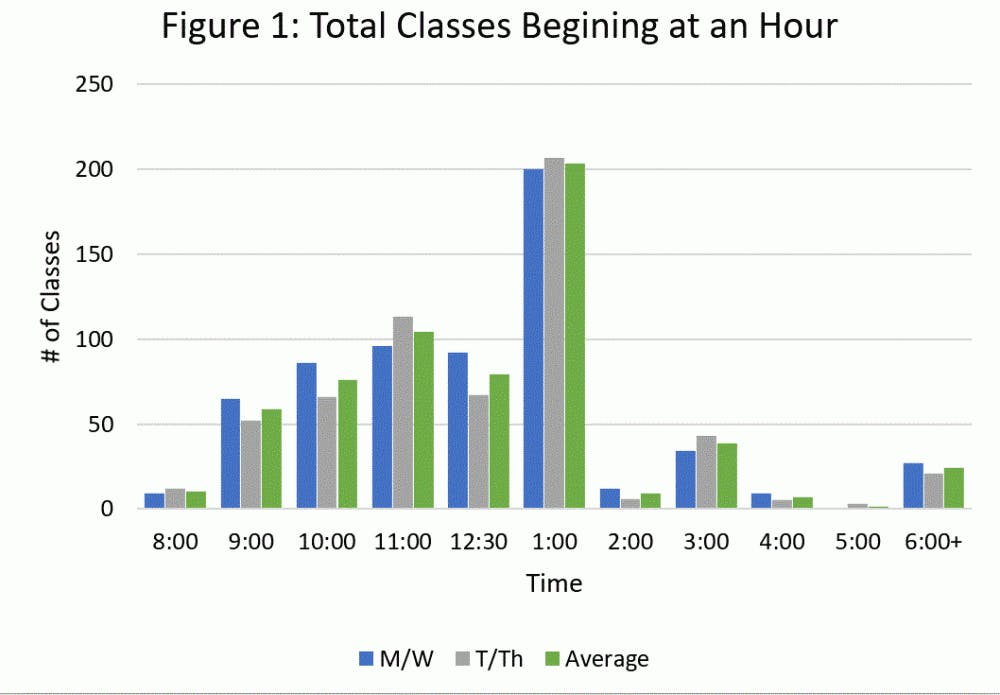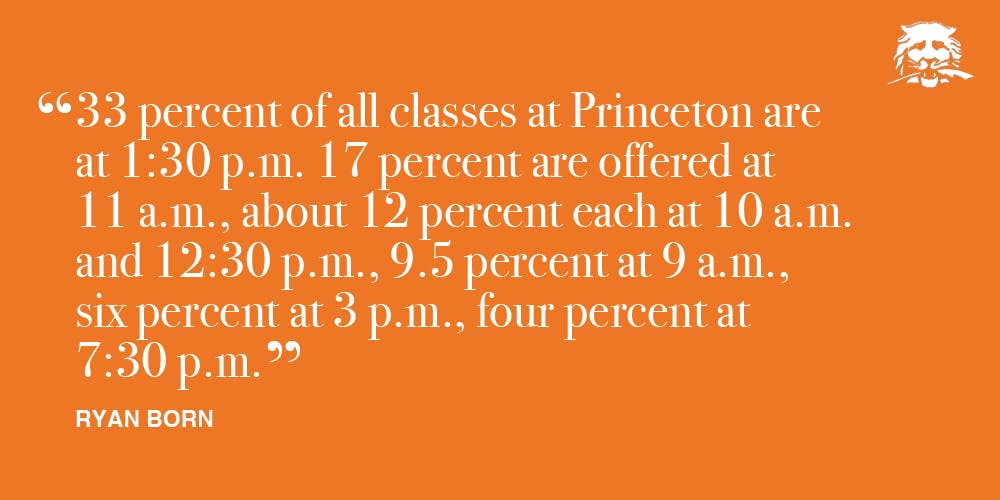I love when new courses come out, and I hate choosing between courses, sentiments which I think are shared among my fellow undergraduates. Despite the inordinate amount of time I pour into course schedules every semester, it was only this semester that I realized something odd. Go into ReCal, the student-developed scheduling app, start adding courses in: soon you’ll realize that you’ve ended up with a few conflicts. And most of them will be at 1:30 p.m.
According to data I collected from the Registrar’s website, there are 1205 classes offered at Princeton this coming semester. While some of these classes are different sections of the same class or graduate classes, this is still a significant number. There are approximately nine offered class times for scheduling purposes. If classes were assigned randomly among all nine time slots, you might expect that you end up with about 133 or so classes per scheduling period (11 percent of all classes). But anyone who has actually looked at class selection here at Princeton knows that’s not the case. 33 percent of all classes at Princeton are at 1:30 p.m. 17 percent are offered at 11 a.m., about 12 percent each at 10 a.m. and 12:30 p.m., 9.5 percent at 9 a.m., six percent at 3 p.m., four percent at 7:30 p.m., with somewhere between one and two percent at all other times. I should note that I cannot account for precepts in my data, but I do not think this is a problem, since precepts are usually offered at many different times, allowing people generally to be able to find a precept for a given class.


Having such an abnormal amount of classes at one period causes some serious problems. While I don’t mean to suggest we should suddenly all take classes at 8:30 a.m. (I’d actually suggest we have no classes earlier than 9:00 a.m.), I do want to critically examine our current course scheduling process.
In the aggregate, the massive spike at 1:30 p.m. can cause some genuine problems. To illustrate, I’ve created some archetypical schedules that are completely impossible. Perhaps a burgeoning economics major with an interest in political theory and business wants to take ECO 302: Econometrics, EGR 200: Creativity, Innovation, and Design, PHI 306: Nietzsche, and POL 303: Modern Political Theory. This schedule is not possible — all four classes are at 1:30 p.m., and all classes conflict in some way. This is merely an illustrative example — I leave it to the reader to play with ReCal to see how many personally disappointing course conflicts they can achieve.

Perhaps even worse is intra-departmental scheduling issues. Many departments are relatively small and only offer relatively few classes. Take Near Eastern Studies (NES). NES offers 19 listed and cross-listed undergraduate courses for next semester. I put all 19 in a ReCal schedule, and this is what I got:

As of writing, the Philosophy department has four classes at 1:30 p.m. on Tuesdays and Thursdays. This is out of a mere 11 non-introduction undergraduate classes. Economics offers 16 electives. Of these, there are three conflicts on Mondays at 11 a.m. and another five at 1:30 p.m.
I don’t want to blow this particular problem out of proportion. Part of Princeton’s abundance of riches is its amazing selection of varied classes over a variety of fields and interests. Normally the problem isn’t that two courses conflict, it’s more that you can’t take more than four or five (or six/seven if you hate yourself). There are plenty of courses that exist that you can reasonably never get totally locked out of a selection that you desire or, at the very least, one that you can live with. In researching this topic, I actually found that the Registrar and most departments do a reasonable job with how they put courses into the calendar, and given different requirements for class sizes and professors, I’m not sure I should really suggest that we can do better. Of course, this analysis doesn’t even begin to attempt to deal with precept scheduling.

Although I do suggest there may be good reasons for how classes are currently scheduled, it is not unreasonable to suggest that a more even distribution of class times would help both students and departments. For students, it would prevent the selection of even a single class from ruling out 16.5 percent of all other options. For departments, a better awareness of when everyone else is scheduling their classes may increase the accessibility of less visible classes. If I am an economics major who has to take a class at 1:30 p.m., and that class conflicts with a bunch of more esoteric (but interesting) classes, I simply cannot take those classes, and may never get to experience that subject. This seems directly contradictory to the goal of a liberal arts education (like the one Princeton purports to support). Classes are also often ephemeral. You can reasonably expect that some classes will always be taught, but will they always be taught by the right professor, at the right time? Despite everything, you’ll still miss opportunities.
At least one part of a solution might be a revision of seminar hours. I think seminars are great and Princeton cannot offer enough seminars over lectures, but I also wonder why we have no three-hour seminars in the morning and very few later than 1:30 p.m. If it is difficult to schedule three hour classes, why don’t we break up three-hour seminars into two 80 minute chunks? Anyone who has been in a seminar knows that many seminars are structured around a 5-10 minute break in the middle anyway. By breaking seminars into more digestible sessions, spreading out their schedules, and limiting the length of lectures, even more conflicts could be avoided. As always, I am far more skeptical of the necessity for 80 minute lectures, given that an 80 minute lecture twice a week is an hour more in the worst possible form of education. Lectures of more than 50 minutes should be as a rule avoided, both to avoid extra lecture time and to prevent even more course conflicts: an 80 minute lecture takes up effectively two class slots, doubling conflicts.
In the end, we all have eight semesters at Princeton — some of us have even fewer with studying abroad. We’re all told to maximize our time here, and no one will argue that the classes you choose are going impact that time. Part of what you choose is the options you’re presented with, and course times are a big part of how we schedule our lives. Who knows how many people have left Princeton without experiencing that one life-changing class, that one class that made it all worth it, because Introduction to Spanish is at 1:30 p.m., and so is everything else.
Ryan Born is a philosophy concentrator from Washington Township, MI. He can be reached at rcborn@princeton.edu.
This is a recurring weekly column on politics and pedagogy at Princeton and abroad.








